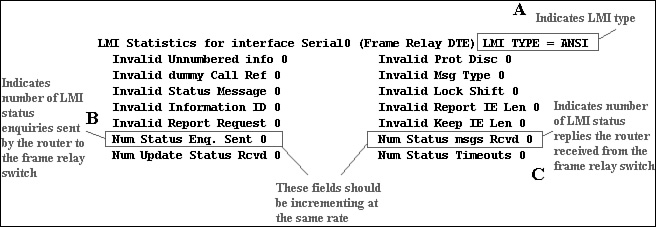Networking Routing Fundamentals
Interface State: Serial x Is Down If serial x is down, this is an indication of a poor physical connection to the DSU/CSU. The router is not receiving all of the control signals from the DSU/CSU. The show interface command will display which control signals are missing (see field C in Figure 3-7). A missing signal will be indicated with a “down” state (such as DCD=down). To correct this problem, you can take the following actions:
Verifying That the Router and Frame Relay Provider Are Properly Exchanging LMIAfter a good physical connection has been established between the router and the local DSU/CSU, the next goal is to verify that the line protocol is up between the router and the Frame Relay provider. For a Frame Relay network, the line protocol is the periodic exchange of local management interface (LMI) packets between the router and the Frame Relay provider. The first line of the show interface command will indicate if line protocol is up or down (see field D in Figure 3-7), indicating whether LMI is properly exchanging or not. The following sections outline the possible line protocol states and offer some suggestions to correct line protocol problems. Line Protocol State: Line Protocol Is Up If the line protocol is up, this is an indication that Frame Relay LMI is properly exchanging between the router and the Frame Relay provider. At this point, you should proceed to Step 3 and verify that the PVC status is active. Line Protocol State: Line Protocol Is Down If the line protocol is down, this is an indication that LMI is not properly exchanging between the router and the Frame Relay provider. To correct this problem, you can take the following actions:
These solutions are covered in greater depth in the sections that follow. Verifying That the Router’s LMI Type Matches the LMI Type Used by the Frame Relay Provider The only parameter that can be configured on the router that relates to the line protocol is the LMI type. After the router is configured with the proper LMI type, all other line protocol problems depend on the DSU/CSU settings or carrier provisioning. The router’s LMI type can be verified with either the show interface command (see the field marked F in Figure 2-12) or the show frame-relay lmi command (see the field marked A in Figure 2-13).
If the Frame Relay provider is using “ANSI Annex-D” LMI, configure the router to use frame-relay lmi-type ansi. Also, be aware that Frame Relay providers often generically refer to lmi-type cisco as simply LMI. If the frame provider states that it is using LMI type LMI, make sure the router is configured to use frame-relay lmi-type cisco. Verifying That the Router Is Sending LMI Packets to the Frame Relay Provider This procedure is a sanity check to make sure the router is doing its half of the LMI exchange. Use either the show interface command (see field E in Figure 3-7) or the show frame-relay lmi (see fields B and C in Figure 2-13) repetitively to determine whether the router is sending LMI packets to the Frame Relay switch. The “Num Status Enq. sent” counter will increment every ten seconds if the router is attempting to send LMI packets. If this counter is not incrementing, re-verify physical connections and make sure the interface is not in shutdown. Alternatively, the debug frame-relay lmi command can be used to actively monitor the exchange of LMI packets. The Num Status Enq. sent counter will increment at the same rate as the Num Status msgs. Rcvd counter if the router is successfully exchanging LMI with the Frame Relay switch. Verifying That DSU/CSU Parameters Are Properly ConfiguredThe successful exchange of LMI packets between the Frame Relay switch and the router relies upon the successful delivery of frames by the DSU/CSU. The router might be sending LMI packets (in which case you should refer to the operations outlined in the two preceding sections), but this is meaningless if the DSU/CSU is not correctly forwarding these frames onto the Frame Relay switch. There are three main parameters that MUST be correctly configured on the DSU/CSU: clocking, framing, and line encoding. The Frame Relay provider supplies the following information:
Verifying That the Frame Relay Provider Has Turned the Circuit On
|
EAN: 2147483647
Pages: 200
